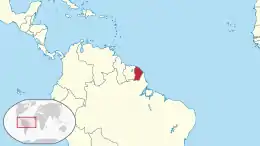Italy and the colonization of the Americas
Italy and the colonization of the Americas was related to: 1) Italian explorers and colonizers serving for other European nations; 2) The role played by the Roman Pontiff in Christianizing the New World and resolving disputes between competing colonial powers; 3) Limited attempts to create a colony in the Americas, by the Grand Duchy of Tuscany in the early 1600s and by an Italian Grand Master of the Knights Hospitaller of Malta (then part of Sicily).
| Part of a series on |
| European colonization of the Americas |
|---|
.svg.png.webp) |
|
|
History
During the colonization of the Americas, Italy was divided between several city-states often in conflict between each other and therefore virtually every Italian state had no colonial ambitions. Nevertheless, Italian navigators from some of the maritime republics of the Mediterranean played a key role in ushering the Age of Discovery and the European colonization of the Americas.

The most notable among them were Christopher Columbus who served for Spain, John Cabot for England, Giovanni Verrazzano for France and Amerigo Vespucci for Portugal. Furthermore, the State of the Church, was involved in resolving disputes between competing colonial powers: an example of this is the ratification of the Treaty of Tordesillas by a papal bull of Pope Julius II.
However, later, in the 17th century, two Italians were particularly interested in colonial affairs: Ferdinando I de' Medici for Tuscany and Giovanni Paolo Lascaris for the Knights of Malta.
Grand Duchy of Tuscany expedition

The Grand Duchy of Tuscany (Ferdinando I) expedition to South America was the only tentative to colonization done by Italians in the centuries after Columbus discovery.
The Thornton expedition was a 1608 Tuscan expedition under Captain Robert Thornton, an Englishman, sent by Ferdinando I of Tuscany to explore northern Brazil and the Amazon River and prepare for the establishment of a settlement in northern coastal South America, which would serve as a base to export Brazilian wood to Renaissance Italy.
The area that Thornton considered as a possible site of a Tuscan or Italian colony now lies in modern French Guiana, near Cayenne,[1] which would be colonised by France in 1630.[2]
In the first years of the 17th century Ferdinando I of Tuscany evaluated the possibility of a colony in Brasil and gave captain Thornton a caravelle and a tartane for an expedition in 1608. Thornton sailed for one year, reaching Guyana and Brasil, exploring the Amazon and Orinoco river but in February of that year the Grand Duke died and in Florence, no one thereafter considered establishing an overseas colony.[3]
Indeed Thornton was ready to sail back to the area between the rivers Orinoco and Amazon in the summer of 1609 with nearly one hundred Italian settlers from Livorno and Lucca to create a settlement in the bay of actual Cayenne, but the project was scrapped.[4] Thornton's galleon 'Santa Lucia' returned to Italy in 1609 with plenty of information (after exploring the area between Trinidad island and the delta of the Amazon river), some indigenous natives of the Americas and a few tropical parrots.[5]
Malta's Knights Hospitaller

Giovanni Paolo Lascaris, Italian nobleman and Grand Master of the Knights Hospitaller of Malta, was interested in colonial affairs and in 1651 bought the island of Saint-Christophe, along with the dependent islands of Saint Croix, Saint Barthélemy, and Saint Martin, from the failing Compagnie des Îles de l'Amérique.[6] The Knights' ambassador to the French court, Jacques de Souvré, signed the agreement.[7]
The Order's proprietary rights were confirmed in a treaty with France two years later: while the king would remain sovereign, the Knights would have complete temporal and spiritual jurisdiction on their islands. The only limits to their rule were that they could only send French knights to govern the islands, and upon the accession of each new King of France they were to provide a gold crown worth 1,000 écus.[8] In 1665, after Lascaris's death, the Knights sold their islands back to France, ending their brief colonial project.
References
- Ridolfi, R. Pensieri medicei di colonizzare il Brasile p. 14
- Ridolfi, R. Pensieri medicei di colonizzare il Brasile, in «Il Veltro», Roma, luglio-agosto 1962, pp. 1-18
- Sanfilippo, Matteo (23 June 2008). "Gli italiani in Brasile - I° parte" [The Italians in Brazil - Part I] (in Italian). Archivio Storico dell'Emigrazione Italiana. ISSN 1973-347X. Archived from the original on 20 July 2011. Retrieved 28 March 2010.
Nei primi anni del Seicento Ferdinando I di Toscana ...valuta la possibilità di una colonia brasiliana...Ferdinando fa armare una caravella e una tartana nel porto di Livorno e le affida al capitano Thornton...Thornton naviga per quasi un anno: approda in Guyana e in Brasile, esplora il Rio delle Amazzoni e l’Orinoco, rientra facendo tappa alla Caienna e a Trinidad. Il 12 luglio 1609 è di nuovo a Livorno, ma...il 7 febbraio di quell’anno il granduca è morto e a Firenze non si pensa più alla possibilità di fondare una colonia...oltreoceano.
- Ridolfi, R. Pensieri medicei di colonizzare il Brasile, in «Il Veltro», Roma, luglio-agosto 1962, p. 12
- Mirabilia et naturalia (in Italian)
- Dubé, Jean-Claude (2005). The Chevalier de Montmagny (1601-1657): First Governor of New France. Translated by Elizabeth Rapley. University of Ottawa Press. pp. 263–287. ISBN 978-0-7766-0559-3.
- Mifsud, A. (1914). "Attempts to reestablish the Tongue". Knights Hospitallers of the Ven. Tongue of England in Malta. AMS Press. p. 246.
- Allen, David F. (1990). "The Social and Religious World of a Knight of Malta in the Caribbean, c. 1632-1660". Libraries and Culture. 25 (2): 147. Archived from the original on 13 April 2014. Retrieved 11 April 2014 – via Malta Historical Society.